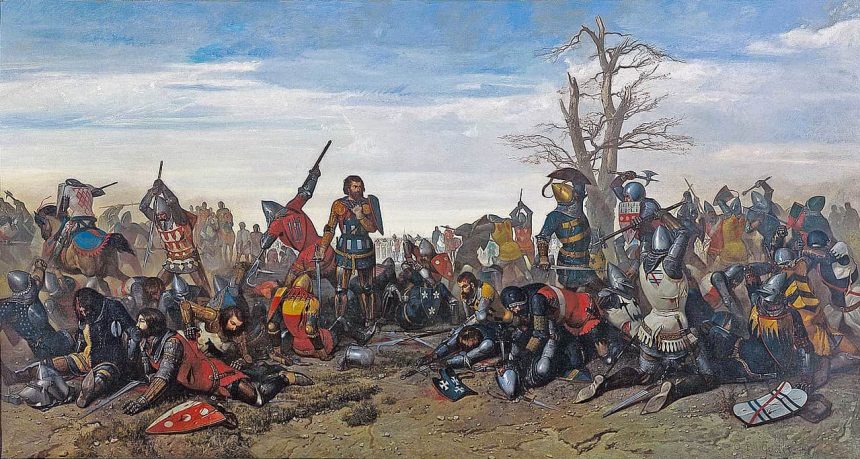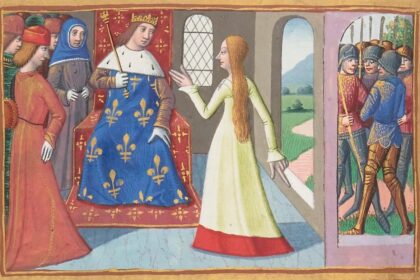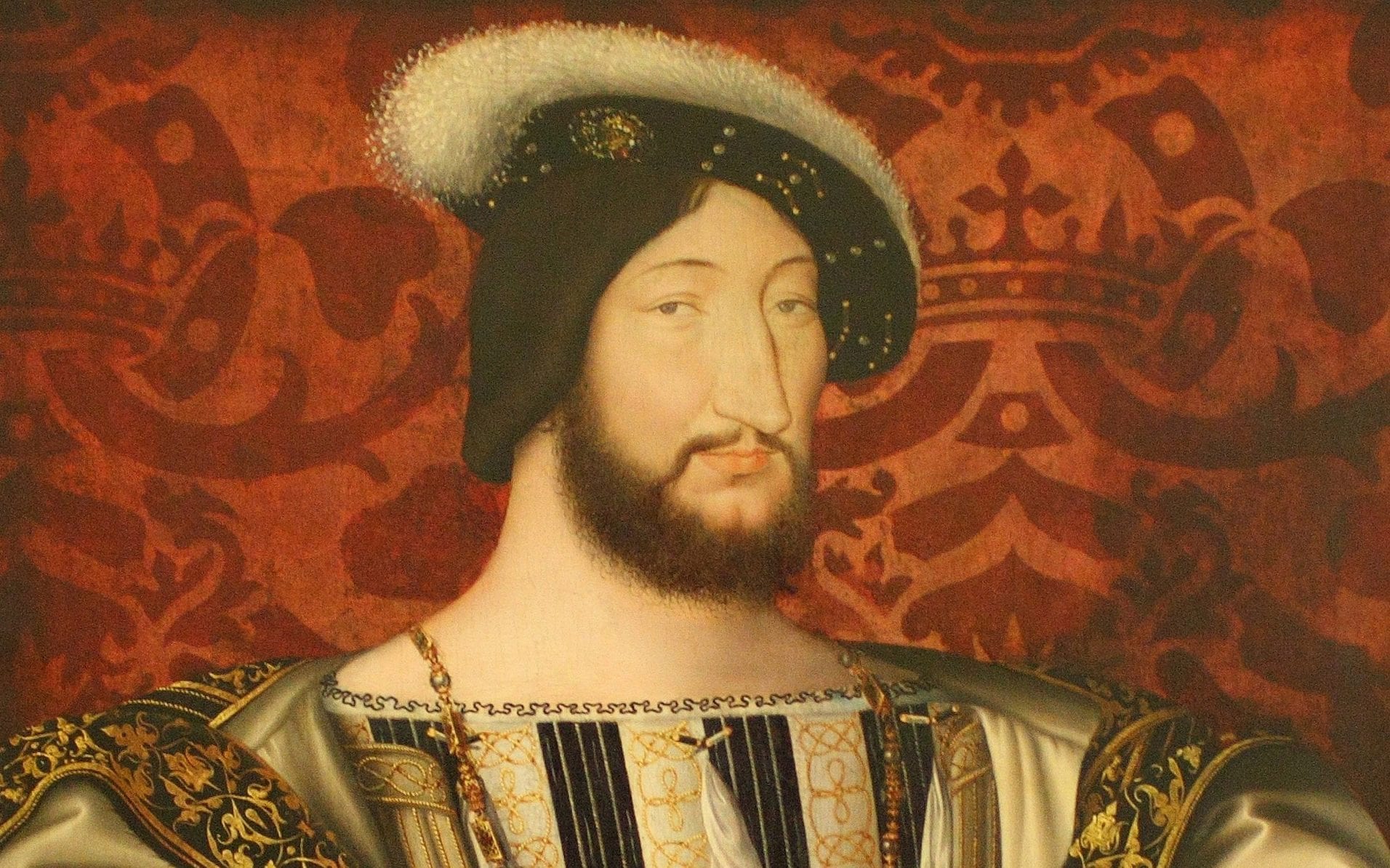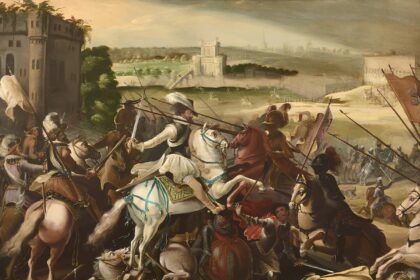The Combat of the Thirty is a marginal episode of the War of the Breton Succession (1341–1365) that took place in March 1351 in the territory of the present commune of Guillac (Morbihan), located between Josselin and Ploërmel.
Thirty supporters of Charles de Blois and thirty supporters of John of Montfort organized a battle after Jean IV de Beaumanoir issued a challenge. The supporters of Charles of Blois-Châtillon emerged victorious, but this had no major consequences for the rest of the war.
Note
The rules of engagement for the Combat of the Thirty allowed for thirty knights from each side to engage in combat. It was agreed that no reinforcements would intervene, and the combatants would fight until one side surrendered or was defeated.
Origins
In 1351, during the War of the Breton Succession, the town of Josselin was in the hands of Jean de Beaumanoir, a supporter of Charles de Blois, while Ploërmel was held by the Englishman Robert Bemborough (or Brandebourch, according to Froissart), a supporter of the House of Montfort. The supporters of Charles de Blois besiege Ploërmel.
One day, while Beaumanoir goes to negotiate with Bemborough, he sees Breton peasants mistreated by English soldiers. He complains to his adversary.
The ensuing dispute leads the two men to determine the terms of a duel aimed at settling the territorial dispute. Jean de Beaumanoir challenges Robert Bemborough by proposing a tournament similar to those of the Knights of the Round Table. Bemborough accepts and proposes thirty fighters on each side.
Timeline
Date
26 March 1351.
Location
The chosen location, the heath of Mi-Voie, is equidistant from Josselin and Ploërmel, near a tree called the “Mi-Voie oak.”
Arrival of the Fighters
On the appointed day, the fighters attend mass at the Notre-Dame du Roncier church in Josselin, then arrive on horseback at the chosen location but enter on foot with their weapons into the enclosed field. They must not leave it under the penalty of dishonor.
The thirty-one Bretons of Jean IV de Beaumanoir immortalize themselves by fighting against the thirty-one men commanded by Bemborough. In this camp is the famous adventurer Croquart, whom Philippe VI de Valois would have liked to recruit. Alongside Robert Knolles, we also notice the nephew of Thomas Dagworth, victor of Charles de Blois at the Battle of La Roche-Derrien.
The Battle
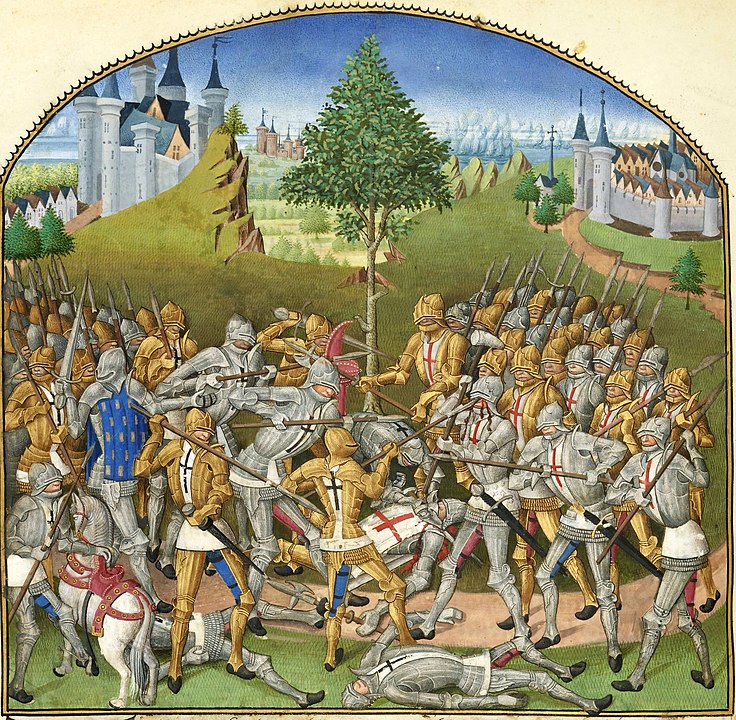
The battle begins in a confused melee. The Blésistes lose several men at first; a break is allowed, during which the fighters refresh themselves with wine from Anjou! The lance of Alain de Keranrais pierces Bemborough as soon as the fighting resumes. Croquart, a German mercenary, takes his place at the head of the Monfortists.
Bemborough and eight of his men are killed, as well as six men from Beaumanoir (not counting those who will die from their wounds). According to legend, the latter, exhausted by the heat, the combat, and fasting, would have asked for a drink, to which his companion Geoffroy du Bois would have replied, “Drink your blood, Beaumanoir; your thirst will pass.” This phrase became the motto of the Beaumanoir family. Guillaume de Montauban managed to break through; the Blésistes then massacred the Monfortists, who would leave the battle “defeated.”
The surviving Anglo-Bretons surrendered because it would have been dishonest to deprive the victors of the benefit of ransoms. In feudal warfare, one does not seek to kill on the battlefield but to make one’s campaign profitable by capturing wealthy prisoners. According to chroniclers, there are between 10 and 17 dead on the Monfortist side and between 4 and 8 on the Blésiste side.
Croquart is declared the best fighter for the Anglo-Bretons, while Alain de Tinténiac is considered the best among Beaumanoir’s men.
Suites
The outcome of the battle resolves nothing: the Blésists besiege Ploërmel in vain until the spring of 1352.
During the Battle of Mauron that takes place shortly after (where the Blésists are defeated), seven of the Bretons who participated in the Combat of the Thirty are present; Beaumanoir and Simon Richard will die years later.
The War of Succession ended in 1365 with the victory of the Montfort camp, represented at the time by Jean de Montfort’s son, Duke Jean IV.
Combatants
In a book published in 1770, Jacques Villaret described the Combat des Trente and provided a list of participants.
Franco-Breton force
Knights
- Sir Jean de Beaumanoir, Constable of Brittany, Governor of Josselin
- Sir Olivier Arrel
- Sir Caron de Bosdegas
- Sir Geoffroy du Bois
- Sir Yves Charruel
- Sir Guy de Rochefort
- Sir Jean Rouxelot
- Sir Robin Raguenel
- Sir Huon de Saint-Hugeon
- Sir Jean de Tinténiac
Squires
- Geoffroy de Beaucorps
- Hughes Capus-le-Sage
- Olivier de Fontenay
- Louis de Goyon
- Alain de Keranrais
- Guillaume de la Lande
- Guillaume de la Marche
- Geoffroy de Mellon †
- Guillaume de Montauban
- Olivier de Monteville
- Maurice du Parc
- Tristan de Pestivien
- Guyon de Pontblanc
- Geoffroy Poulard †
- Simonet Pachard
- Geoffroy de la Roche
- Jean de Serent
- Alain de Tinténiac
- Maurice de Tréziguify
- Geslin de Trésiguidy
Anglo-Breton Force
Knights
- Sir Robert Bemborough, Captain of Ploërmel †
- Sir Robert Knolles
- Sir Thomas Billefort
- Sir Thomas Walton
- Sir Hugh Calveley
- Sir Hervé Laxaualan
- Sir Richard Lalande
Squires and men-at-arms
- John Plesington
- Richard Gaillard
- Hughes Gaillard
- Huceton Clemenbean
- Hennequin de Guenchamp
- Renequin Hérouart
- Hennequin Le Mareschal
- Raoulet d’Aspremont
- Gaultier l’Alemant
- Bobinet Melipart
- Jean Troussel
- Robin Adès
- Perrot Gannelon
- Guillemin-le-Gaillard
- Jennequin Taillard
- Rango-le-Couart
- Raoul Prévot
- Dardaine †
- Repefort
- Croquart the German
- Isannay
- Dagworth (nephew of Sir Thomas Dagworth)
- Helichon
- Helecoq
Tales of Combat
The chronicler Jean Froissart composed a lengthy poem detailing the Combat of the Thirty, titled “Here begins the battle of thirty Englishmen and thirty Bretons, which took place in Brittany, in the year of grace one thousand three hundred and fifty, on the Saturday before Laetare Jerusalem”; this text is accessible on the mentioned website.
Théodore Hersart de La Villemarqué authored The Battle of the Thirty, a poem found in the Barzaz Breiz, drawing inspiration, albeit modified, from Froissart’s work.
Historical Interpretation
Presenting this battle solely as an Anglo-Breton confrontation risks distorting historical truth. It is a pivotal episode of the War of Succession of Brittany, involving one faction led by the nephew of the French king and the other supported by England.
According to historian Jean-Jacques Monnier, the author of History of Brittany for Everyone, “this battle lacked significant historical impact. It essentially comprised French-leaning knights facing off against English-leaning knights, resulting in minimal consequences. It resembled more of a tournament. The battle remained largely forgotten until its resurrection around 1880 during the Third Republic, driven by a desire for commemorative events. This ancient symbol garnered unanimous support from both the right and the left during a period characterized by a thirst for revenge. Patriotism needed to be mobilized!”


